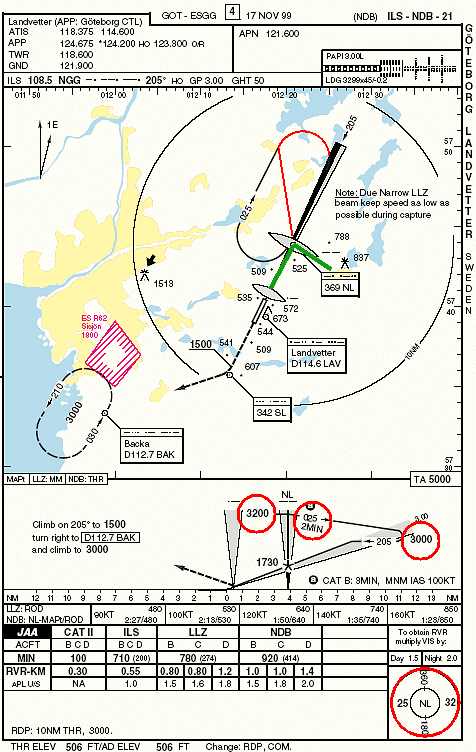How to get Connected¶
The most common way to establish on a final approach is radar vectoring.
The ATC will vector to an intercept of the localizor with an angle of 30º.
In case there is no radar available you will have to make a procedure turn
instead.
This procedure will be done from the OM (Outer Marker) or sometimes from a
radial and distance of a VOR.
Look at this IAL chart for ESGG RWY21.
There is no radar available and you will have to make a procedure turn over NL
to establish on the LOC for RWY21.

There are a couple of important things to look at. In the lower right corner is
the MSA (Minimum Sector Altitude). This is the altitude that will give 1000ft
separation to ground within 25NM from the center aid (in this case NL). This is
the lowest altitude to be used IMC until you are established in the procedure.
In this case 3200ft.
The red track from NL is the procedure turn and to establish over NL you should
fly inside the blue sector. It is often best to fly towards the VOR LAV and
turn inbound NL (when inside the green sector). Otherwise it´s also possible to
make a normal entry into the racetrack (the same way as into a holding), but
this will often take more time.
When you arrive over NL, turn left to a 30º offset track (HDG 355º) for 1 min
30 seconds. The time on the out bound leg is two minutes. To stay within the
obstacle clearance sector turn to a parallel track of 025º the last 30 seconds.
Then turn right to the normal intercept of 30º to the Localizer (HDG 175º) and
continue on the normal ILS approach.
After passing NL (on the out bound leg) you are free to descend to 3000ft.
It is essential to stay on the right side of the LOC during this procedure.
Otherwise you will not be sure of obstacles clearance. It is also essential to
keep the speed down, dependent of the A/C type, but a MD80/B737 speeds around
180kts.
Remember the wind direction and compensate.